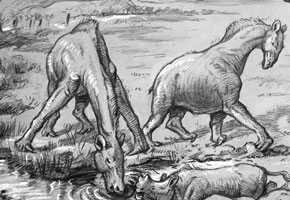 |
| Chalicotheres: Evolution's Version of the 80's. From AMNH Library Special Collections Neg No. 36900 |
Knuckle-walking today is commonly associated with the great apes, but they aren't the only ones who said "palms are for dumbies, lets walk on the opposite sides of our hands because that makes total sense somehow." Anteaters and platypus also knuckle-walk, as did giant ground sloths. Knuckle-walking, like trunks, seems to have been one of the oh-so-cool adaptations that a lot of clades did when they got too chic.
 |
| Bitch please, we knuckle-walked before it was cool |
So why were (some) chalicotheres knuckle-walking? They had larged, hooked claws and their hips were adapted to support occasionally standing on two limbs, so it may be that they were using their claws to pull down branches to eat. That would make those claws important, and make protecting those claws also very important. Some chalicotheres even had fused, claw-like fingers to support their weight while walking on their knuckles.
 |
| Figure of Moropus romancing a tree, from Coombs 1983 |
Chalicotheres had some other odd characteristics too - those of the genus Tylocephalonyx had big domes on their head like pachycephalosaurs (aka those dinosaurs that look like bipedal battering rams). But the domed skull of these chalicotheres weren't so well adapted for beating each other about the brain - to run at one another in the way a ram does, you need to transmit a lot of force so your noggin doesn't crumple inward like a deflating basketball. It turns out domed heads have a lot of different potential uses! If they're full of air, they can help the animal's boyancy - but Tylocephalonyx's dome space volume was too small, and also a super awkward placement as it turns out that if you wear arm floaties on tippy-top of your head you're still probably going to drown.
 |
| Cuz this just isn't that helpful. |
Some seals have big domed heads to attach muscles to, so they have a stronger bite, but the dome is too far back to make that muscle more effective. Well that and their teeth couldn't really handle a stronger bite so there wouldn't be much point to biggering and bettering that muscle group.
Some desert animals have evolved complex pathways in their skulls that help to humidify air and prevent water loss, but those don't seem to be present in chalicothere skulls. Having additional space for the thin struts of bone that support membranes in most animal's muzzles (called turbinates) is sometimes linked with a better sense of smell, but they don't seem to have those thin bones so the dome probably wasn't a smell-amplifying arena either. The dome doesn't hide a single resonating chamber either, so it probably wasn't like the enormous bone fins of Hadrosaurs, which may have helped them make cool sounds.
 |
| Looks like a horn, sounds like... not much. |
 |
| Alternate hypothesis: touching of the cones = sexy time????? |
Works Cited
Fish, Frank E., et al. "Energetics of terrestrial locomotion of the platypus Ornithorhynchus anatinus." Journal of Experimental Biology 204.4 (2001): 797-803.
Munthe, Jens, and Margery C. Coombs. "Miocene dome-skulled chalicotheres (Mammalia, Perissodactyla) from the Western United States: a preliminary discussion of a bizarre structure." Journal of Paleontology (1979): 77-91.
Orr, Caley M. "Knuckle‐walking anteater: A convergence test of adaptation for purported knuckle‐walking features of african Hominidae." American journal of physical anthropology 128.3 (2005): 639-658.
Coombs, Margery C., and Bruce M. Rothschild. "Phalangeal fusion in schizotheriine chalicotheres (Mammalia, Perissodactyla)." Journal of Paleontology (1999): 682-690.
Coombs, Margery Chalifoux. "Large mammalian clawed herbivores: a comparative study." Transactions of the American Philosophical Society(1983): 1-96.

No comments:
Post a Comment